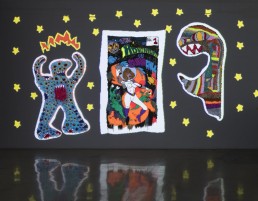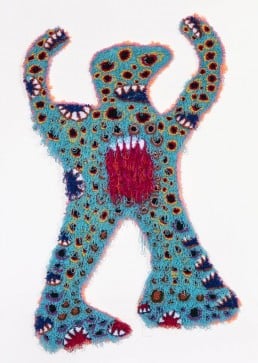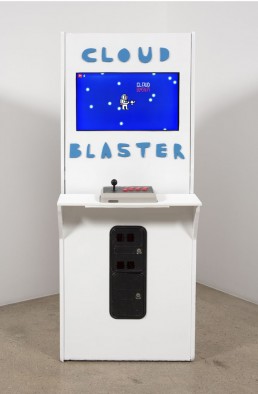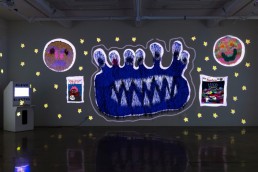Interviews
"God is dead, which is fine, so I see it as an artistic duty to create guideposts in a chaotic darkness"
DO YOU WANT A FREE TRIP TO OUTER SPACE? by Hannah EpsteinJanuary 5 – February 16, 2019 at Steve Turner

The most integrated presentation of her work to-date, Hannah Epstein’s current solo exhibition DO YOU WANT A FREE TRIP TO OUTER SPACE? at Los Angeles-based Steve Turner, invites the viewer into a cartoonish, immersive outer space environment. Having been raised on a mixture of film, television, video games, and literature, the Nova Scotia-born artist draws on a wide net of mediums, through which she challenges and reshapes dominant narratives. DO YOU WANT A FREE TRIP TO OUTER SPACE? serves not only as a vehicle for travel into other worlds, but also as a space dedicated to confronting the ways in which the human soul suffers under our current cultural conditions. In her own words, “I want to ‘let the sunshine in’ and coax us toward a collective awakening”.
Do You Want A Free Trip To Outer Space? is your second solo exhibition at Steve Turner. Can you give us some insights into your thoughts behind the exhibition?
At its core, the show is an immersive, handmade, textile comic book that follows the story of Superchill and her chill adventure in outer space. On the walls hang planetary bodies, alien creatures and comic book panels- all illuminated by six projectors running projection-mapped, animated frames.
Since my first solo with Steve Turner, Monster World, exclusively showed textiles it was important to me that the new show offer a more comprehensive view of my practice and move me away from any limitations that might come with specific labels like, “textile artist”.

The title Do You Want A Free Trip To Outer Space? is playful and alluring, and yet, it also seems to indicate a sort of distancing from the world as we know it. Can you elaborate a bit on the exhibition title?
The title is on one level a literal and sincere invitation to the viewer to come along for a make-believe trip to outer space and on another level it is referring to the various ways in which our cultural understanding of outer space is being carved up and redefined.
With capstone PR stunts like blasting a sports car piloted by an empty space suit, Elon Musk’s SpaceX and Richard Branson’s Virgin Galactic are companies endeavoring to pursue a capitalist agenda beyond planet Earth. With promises to create space tourism and the colonization of Mars, these companies aim to establish their brands in the yet unbranded vastness of space. Trump’s fantasy about creating a military presence outside our atmosphere with “Space Force” contains a promise that space will be yet another arena for human conflict.
When examining the emerging cultural narrative around outer space, it no longer seems to serve as a realm of poetic reflection and contemplation. It is becoming an extension of the worst parts of what humanity as we burn one planet and search to colonize and repeat the same pattern on others.
This show invites the viewer into a homemade outer space environment where a different narrative takes shape, one where the realm of space is free and accessible to anyone who wants to show up. Superchill, leading by example, represents an explorer who comes to chill.

With hooked rugs, animations and a video game, you work at the intersection of the tactile, describing yourself as “a feminist folklorist of the Internet Age”. Can you talk about the blending of the historical and the contemporary in your work, the process-oriented textile craftsmanship and the technology-driven aesthetics?
All categories are collapsing in on themselves. The usual categories of “painter”, “sculptor”, “video artist” are falling away into a broader understanding of the artist as they and their work exist across a myriad of platforms, both digital and physical.
This increased blending of mediums with which an artist works is an inevitable process when technology changes and evolves so quickly. It is impossible for an artist to act like a machine and simply replace all previous programming with the new software. They are more likely to integrate all previous programming. In my personal experience I have gone from using VHS to DVD to online streaming platforms but I’ve never considered any of these media formats as “obsolete”. The rapid succession of technology meant that I had players stacked on top of each other, so I could play a favourite VHS before switching to Netflix.
Expanded to textile, I always admired the old hooked rugs of my home when growing up in Nova Scotia. By picking up the technique and recycling the tradition, I am discarding the false narrative that we must adopt new technology as it develops, rejecting all others that came before. I see value in every stage of technological development and consider “traditional craft” as vital in the present as any 3D modeled, laser cut, AI generated, VR experience.

I note that your 2018 solo exhibition at Steve Turner included hooked rugs of monsters and internet memes presented on the gallery’s white walls with conventional gallery lighting. In your current show, you are presenting hooked rugs again but without any lights. Instead, you chose to light the works with animations that are being projected onto the walls by six projectors. In short, what made you want to go dark and animate?
I often experience coldness in the white cube gallery space, one where the space feels sterile and inhospitable. That is part of what makes it an elite and alluring space, one that can elevate work, as it did with my first show, but I wanted this show to exude a warmer, welcoming environment.
For the new show, I am casting aside any dialogue with the gallery as highbrow aesthetic arena and transforming it into a vehicle for travel into other worlds.
Superchill is the title character in your new comic strip presented in Do You Want A Free Trip To Outer Space? I am interested to know more about this very relaxed female superhero. Is she a reaction to the sense of anxiety that seems heightened over the past few years? Are you suggesting that the male superheroes of great fame (Superman, Spiderman, etc.) have somehow failed society? And what is the relevance of Freakout Girl, the other human character in your show?
In the hanski comic universe, Superchill and Freakout Girl personify the two biggest powers struggles. Superchill, with her superpower of remaining chill in any situation finds her counterpart in Freakout Girl, whose superpower is constantly being freaked out by everything. Where Marvel and DC might have “good” VS “evil”, the hanski-verse has chilling and freaking.
The politics of our world are often echoed in the world of superheroes and the same is occurring in the Superchill/Freakout Girl narrative. Marvel or DC will take a real war, like WWII and create alternative histories for its characters to inhabit, where the characters of my comic universe take a more reflective tone.
Superchill personifies an answer to a question I ask all the time- where are the leaders whose examples we strive to emulate? This is hardly articulated enough, but we humans are a mimicking species, which is why it is important for functional societies to have good role models. God is dead, which is fine, so I see it as an artistic duty to create guideposts in a chaotic darkness.


“I think of textiles as comics with texture. So in the same way that comics can relate a story through image and text, textiles do the same.” In the above quote from an interview with NOW, you talk about constructing narratives. Can you talk about the element of storytelling in your work?
I think of storytelling as constant activity we are all engaged in. You might say, “But Hannah, I’m not a good storyteller”, meaning you don’t feel confident reciting an anecdote in an entertaining manner, but that’s not what I mean when I talk about storytelling. If everything around us is chaos, storytelling is a scaffold around which to build and recognize patterns. I can tell you a story like, “once there was a sun, it is night now, but there will be a sun again”, and when morning comes you see that the sun has returned and this creates an understanding, however rudimentary, that this is what happens- the sun goes, but it comes back. That story is then told in a variety of ways, scientifically (the earth revolves around the sun), ritually (solstice celebrations) etc.
Getting back to the first part of your question, I am usually more interested in the type of story that is found outside of mainstream culture. Because comics and textiles have both existed outside the canon of art history they are the ideal place to inject new, counterculture narratives. It is in the unofficial margins where dominant narratives can be challenged and reshaped.
You grew up in Halifax, Nova Scotia, a Canadian maritime provinces located on the North Atlantic Coast of North America and later studied in Newfoundland, an even more remote Canadian province. How has your upbringing shaped your ideas and artistic motivations?
Growing up in Nova Scotia, I felt like I was always on the outside looking in. American culture came through on a few select channels at certain times of the day and those glimpses showed me a brilliant, colorful world that seemed as absurd as it was hypnotizing. That kind of distance allows a person to retain a critical edge- one that’s necessary when creating counter-culture narratives.
I was drawn to Newfoundland, because it seemed the furthest vantage point for looking in to the North American mentality. It is also the only place in Canada you can get a B.A. in Folklore. As an area of study, folklore exists as an anti-academic-academic discipline. Instead of looking towards the established orthodoxy of knowledge it demands you look to your own neighbors as repositories of knowledge that is valuable and worthy of serious consideration. I think there is something in cultivating the ability to look in from outside and look around from inside that is constantly at work in the way I perceive and interact with culture.

You draw on a visual vocabulary of cartoon and pop culture images that resonate with the folkloric tradition, thus creating a dynamic interplay between the realm of our everyday life and the mythical. Can you talk about your sources of inspiration and how they feed into each other?
The experience of the world that is shaped by mythic and archetypal narratives continues to define the human cultural experience. Whether the figures that reign supreme in your mind come from literature, some sacred text or Saturday morning cartoons, we constantly encounter characters with which we can identify, deify or condemn. For myself, having been raised on a mixture of film, television, video games and literature. I’m not sure I can separate how they all interact but I can list some and their associations; The Simpsons (family archetypes), David Suzuki (champion of the natural world), Orson Welles (the trickster), Xena Warrior Princess (overcoming a violent past and the path to redemption), Morvern Callar (the wild woman), Mickey & Mallory Knox (unbound love), Alan Watts (western prophet for eastern philosophy), Bikini Kill (rebel grrrl), Zelda: Ocarina of Time (adventure and courage), Mr. Show & Monty Python (comedy and absurdity), Big Brother (the technological villain), Jan Svankmajer’s Faust (the folly of man). This list goes on forever.
You have said that your are driven by an impulse to stir things up. More specifically, what or who would you like to confront?
I would like to confront, quite plainly, the ways in which the human soul suffers under our current cultural conditions. Any gesture to “stir things up” is a signal that other realities are real possibilities. I want to “let the sunshine in” and coax us toward a manifestation of our positive potential as a species. Is that silly or is it desperately necessary? I want to confront the cynical voice within the reader that would say these desires are foolish or naive.
In your current show, Superchill goes to outer space. Should we conclude from the title of your comic strip (“The Adventures of Superchill”) that more episodes are forthcoming?
Indeed I would love to see Superchill and Freakout Girl reappear in future comic works but I’m not going to force it. Contrary to the system of entertainment, which regularly spits out episodic film releases of their franchise properties, these characters will live and develop in their own time.
DO YOU WANT A FREE TRIP TO OUTER SPACE?
A solo exhibition by Hannah Epstein
January 5 – February 16, 2019
Steve Turner, Los Angeles